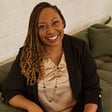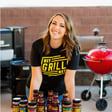Introduction to Collections and The Brands That Book Show
00:00:05
Speaker
I think it's important to have multiple collections because people need something to compare against, all right? People more easily understand the value of something if they can compare it against something else. Welcome to the Brands That Book Show, where we help creative service-based businesses build their brands and find more clients. I'm your host, Davy Jones.
00:00:33
Speaker
Today we are talking about crafting prices, why collections or packages matter, what should go in collections, tips for setting prices, and how to resent your collections to potential clients.
Guest Introduction and Podcast Engagement
00:00:44
Speaker
Pinterest strategist Vanessa Kynes joins me for the conversation. Before we get to the episode, I have a request. If you've enjoyed the Brancetbook podcast, would you take a minute to rate and review the podcast on iTunes? Doing so will help this podcast get more visibility, and it would mean a lot to me.
00:00:59
Speaker
Be sure to check out the show notes at DaveyandChrista.com for the resources we mentioned during the episode. And like I said, I'd like to hear from you about what kind of content you'd like to see on the brands that book podcast as we move
Episode Kickoff: Bulk Recording and Planning
00:01:09
Speaker
forward. To leave your feedback, head on over to the Davey and Christa Facebook page or to our Instagram account at DaveyandChrista and send us a message. Now on to the episode.
00:01:23
Speaker
All right. We are back. Another episode of Brands of Bulk. This is actually the second episode that Vanessa and I are recording here. We usually do these in bulk. And who knows which episode will go live first. Kristin would be proud of our efficiency. That's right. That's right. I like how we always bulk and we always plan about an hour for two episodes and we always go over.
00:01:47
Speaker
So much to talk about, especially with today's topic.
The Role of Collections in Pricing Strategy
00:01:50
Speaker
So I'm excited to get into it. That's right. And so in this episode, we're going to be talking about crafting your prices. All right. So trying to get to yes with the focus on putting together your collections. We're going to talk a little bit about why collections are important.
00:02:04
Speaker
you know, the kinds of things that should go into each of your collections, how you should price those collections. So we're going to try to cover a lot of that today. And if you're interested, I've written pretty extensively on pricing at this point on the blog. So beyond just the corresponding blog post to this episode, there are a number of other posts on pricing as well that you can check out if you're interested.
00:02:24
Speaker
Yeah, and you guys also, I mean, just to put a plug in, David did not say do this, you guys have a couple paid products that actually relate to this, like a PDF guide, you have add on pages to make it easier for your clients to make those decisions, right? We do. Yeah. And so we have just like you said, a PDF guide for those people who are interested in either printing something out, or just having an attachment that you can send in the email. And then for those people who would rather keep everything online, and sort of the way
Effective Pricing Presentation Techniques
00:02:51
Speaker
that we recommend people do it nowadays just because sometimes attachments don't load on computers for whatever reason because they're too or in an email because they're too large or maybe an attachment won't render properly on somebody's computer because they don't have the right software, this, that. Just sending a link to a page on your website that's hidden with your pricing is often a pretty seamless experience.
00:03:12
Speaker
Okay, can I just comment on that two things about that? Because I'm afraid I'll forget later on in the conversation. Sure. Number one is I can see the value of having a web page that you send people to. Because somebody else, let's say you're doing like wedding photography, somebody else could send that page, hey, I worked with Davey and Chris that
00:03:29
Speaker
Spoiler, they're no longer doing photography. But I loved working with them. This is a link to their product pages. And I feel like that translates better. It's easy for people to share than just a PDF because they might have to dig through their email to find it. Yeah, sure. And the nice thing about that is let's say your prices have increased in the time being, right? Like if someone were to send that PDF,
00:03:48
Speaker
say your wedding photographer and you shot somebody's wedding, they loved you, their friends are getting married, but it's like a year and a half later. And so your prices have been increased. But they send that PDF over. Well, that PDF is going to reflect your two-year-ago prices, right? Whereas your website is going to be updated so that people see the latest pricing. So you don't have to answer that awkward question of, well, why are you so much more
Understanding Client Decision-Making with Collections
00:04:12
Speaker
expensive now? Which
00:04:13
Speaker
shouldn't be an awkward question to answer like you should be able to answer that confidently, but still you get to avoid that question altogether. Yeah, that is a great point. That is the number one reason why you should have it on your website, if anything right there. Sure. And we think again, it's just a seamless way to enhance your client experience.
00:04:29
Speaker
Yeah, totally. So why should we be creating collections for our services? Like what is the science behind it? Yeah, I think there are at least three things that I want to cover as far as collections go. And the alternative or at least one of the alternatives that I'm speaking to here is or speaking against rather is having a like build your own, you know, or just even a single collection.
00:04:51
Speaker
Yeah, exactly. I think it's important to have multiple collections because people need something to compare against. People more easily understand the value of something if they can compare it against something else. There's some science behind this. Of course, I don't have ... I meant to have that right out in front of me while we did this podcast. Check the corresponding blog post and I'll list the study in there, but people need something to compare against.
00:05:20
Speaker
Okay, so actually, I remember it. Yeah, I remember it was about jam, there were 20 options. And like, I think it led to like only 15% of people tasting the jam. But when there were six options, it was like 30%. Am I right? Is something like so that actually leads us into our next point really well. So that's a study that corresponds with a different point that I want to make. So this other study, and actually, now that I think about it, it might not even be in the blog post, but I will definitely list it in the show notes for here. But when people have another option, it helps them make a decision.
00:05:50
Speaker
Okay. So that's one of the reasons why you should have a collection. As far as options go though, you don't want to give people too few options or too many options. When you give people too many options, it prevents them from making the decision. So that's where this study about JAM comes in. So these
00:06:08
Speaker
Researchers went to a grocery store. They set up a free sample stand of 24 jams one week. A certain amount of people came and tasted the jams, but only 3% purchased. The following week, they came back, set up the same stand, but with only six variations of jam.
00:06:24
Speaker
and then 30% purchased. And that's such a significant increase, right? Yeah, so it really speaks to limiting people's options and that giving them better allowing them to make a decision or better enabling them to make a decision. This reminds me as another example when you go to IHOP.
00:06:41
Speaker
It is, you know, I have kids they love. The menu has, I'm not joking, at least 60 different options. And the variations are really confusing. Like what you're getting, this one's bacon, this one's sausage. And they honestly overwhelm me. So what I do for my kiddos is I tend to choose three and make them choose from those three because otherwise I think they're overwhelmed, you know, and no one can make a decision. The waiter's waiting. So even myself, I can see how like reducing the options is really helpful.
00:07:10
Speaker
Yeah, and I'm not even sure why restaurants, I'm not sure why restaurants do that, you know, or certain restaurants, like I hop why they have so many different decisions because it is overwhelming. And it's so nice to go sit down at a place where there's not 1000 different choices on a menu.
00:07:23
Speaker
I think it's different though, higher end restaurants tend to have less options. So there might be something to that. Oh, for sure. And you know, I mean, just in places where you should look kind of for inspiration or look to for guidance, you know, higher end restaurants, you'll notice that oftentimes they just have the number for the price. So let's say the entree is $16. They drop the dollar sign, because for whatever reason, when we don't see the dollar sign, when we see the dollar sign, we think more expensive. All right. So there's all sorts of things that we can learn from restaurants in that respect. Interesting. Yeah.
00:07:52
Speaker
So a note about options. When we crafted our own wedding collections, we had three different options. Even for website design now, we have really two different options. A third, if you count the template option of just purchasing it yourself and building it, but we have two different options for website design and a couple of different options that include brand design as well.
00:08:13
Speaker
but we've limited it to no more than five different options. Again, for wedding photography, we had three different collections. We didn't have eight different collections. We
Strategies for Offering Multiple Packages
00:08:22
Speaker
kept it at three. We found that that was a really good number. I think you have different collections for Pinterest management, right? Yeah, I have three. I have a consultation call. It's just like a coaching call one time. I have my management, which is my most popular option. Then I also have a setup, which is basically working with me for one month.
00:08:39
Speaker
And by far, I would call it like my middle option, my management option is the most popular. So and that's good. And we really want people, you know, I call it the money making middle. All right, we really want most of our most of our clients should be booking our middle option. They shouldn't be booking our least expensive option.
00:08:57
Speaker
And just naturally, our most expensive option should have all the bells and whistles, so not everybody's going to book that. So it really should be that middle option. And we can talk about that in a second on how to price things so that people are sort of encouraged to the middle there. But one other point I want to make just about having collections in general is that it's an opportunity to educate clients.
00:09:17
Speaker
You know, especially I think this is true. I mean, even a Pinterest management, right? Like when we went to you about Pinterest, yeah, we were familiar with it as a tool and Krista, you know, certainly uses it. I don't use it though. And so having packages to choose from helps me understand what I should be looking for, right? And the way that you built your collections, you probably put things in there so that I know I should be looking for those things.
00:09:41
Speaker
Yeah, and there's actually a couple of things that I do. I sometimes actually throw in extra things that I know other Pinterest managers aren't doing that maybe are in the testing phase, but I still feel like are valuable to be using into those packages so people can see that added value in there as well.
00:09:56
Speaker
And they can ask like, Hey, so what is this? And then when, if they're, if they are interviewing another Pinterest manager, they might say, Hey, what, what, you know, like, uh, somebody I'm talking to is doing XYZ, you know, what about that? Right. And so it allows you, I think, to steer the ship, uh, so to speak. But.
00:10:12
Speaker
In wedding photography even, we included an engagement session in every single one of our collections because we knew that the experience was going to be so much better for people on their wedding day if they had done an engagement session. Not only for that person because they're more comfortable in front of the camera, but for us too because it gives us an opportunity to build trust with our clients. Those clients, family, and friends, they've often seen the engagement pictures by the time the wedding rolls around.
00:10:37
Speaker
And so they're not going to be on our back about, hey, make sure you're getting this shot. Or are you going to do this? Are you going to do that? They just trust us because they saw the engagement photos. And they realized the engagement photos are beautiful. So we'll most likely do a really good job on the wedding day as well. I love that. So it's kind of like a practice round with your clients, getting them used to how you interact
Educating Clients Through Collections
00:10:56
Speaker
with them. And then like you mentioned, by the time the wedding comes around, they know you maybe they have some inside jokes with you and they're comfortable around you. That's so valuable.
00:11:04
Speaker
Absolutely. And we wanted people to do that. And just another way, I mean, just in talking through your collections with somebody, you can start educating people on why those things are in the collection and what they might need and what they might not need. Is your wedding, is the entire wedding from getting ready to the reception all in the same location?
00:11:23
Speaker
Well, you probably only need this collection in this many hours, right? So there's all sorts of ways that you can use the collections to educate people and really kind of enhance your client experience, at least make you look more trustworthy during that consultation. You know, one thing I was thinking about is when you have brides, for example, who are shopping around for photographers, and they often are. If you have one photographer who has kind of just like a big, messy, build your own a la carte option, 20 different options, and then you have someone with packages,
00:11:52
Speaker
I mean, I guarantee you might actually, well, I can't guarantee you, but you might actually lose your client when you're confusing them and making things more complicated for them. So I would argue that doing this is super important to just making sure that you're kind of beating your competition who's making things more confusing.
00:12:08
Speaker
Absolutely. I think it looks streamlined. I think it looks high-end. It looks professional, for sure, just to have a certain amount of collections. We think people want choice. We think we want choices. I think at some point in life, we realize we don't. At least that's for me. I think if you asked me when I was in high school or right after in college, maybe I would think that choice equals freedom. But now I'm like, now I literally go to Krista. I'm like, Krista, what should I do? Want somebody to make a decision for me? Yeah.
00:12:38
Speaker
Yeah, no, but a good a good conversation to have is what to put in those collections. And I think that's what we were just talking about is a good segue into that, you know, for us when we were doing wedding photography, it was engagement sessions, right? Because we just knew if you didn't do engagement session, we didn't have an opportunity to educate you in the ways that we want to educate you before your wedding day for website design, it's search engine optimization. We are we are experts in search engine optimization. And so why wouldn't we include those in in a
00:13:07
Speaker
Are packages and then you know as another example did some coaching with a brand photographers who i don't the podcast not too long ago erica and john there out based in scottsdale and super talented brand photographers but one thing as we're talking about their pricing structure one thing that they didn't one thing that sets them apart.
00:13:26
Speaker
All right, that I think makes them really special, but they didn't initially include in their collections was it was basically like consulting around styling, you know, both wardrobe and products, you know, it was like, hey, either you can do this and we'll just shoot it. So they had a package of that where it was just like, we show up and shoot and you kind of work out those details. But through talking with them, you know, realizing that's really what set them apart. We built that into their collections and then we just increased the prices of their collections.
00:13:56
Speaker
And guess what, you know, I mean, one of the end results and it was all sorts of other things too, but was becoming more profitable. How do you feel about like surprise gifts, like a week before the wedding, you're like, guess what, I'm going to give you a free extra hour of shooting that kind
Enhancing Value with Surprise Additions
00:14:10
Speaker
of thing. Yeah, absolutely. I mean, I know that there's a I know that's a pretty popular thing to do. I know our friend, Caitlin James does that, you know, she surprises people with an hour
00:14:18
Speaker
an additional hour, hour of coverage, because what she recognized is that that's a big stressor for people. How much you know, how much coverage do I need? And then as the wedding day got closer, people would often say, I think I'm going to need another hour, can I just have you stay for another hour? And so it was a huge, it was like a big bonus for people, huge value add when Caitlin would be like, Oh, yeah, well, you know what, this is my wedding gift to you, we'll stay for another hour.
00:14:42
Speaker
love it. I love that idea. Yeah. So my biggest question is, so how do you price your collections? So how do you start to think about these packages and what do you want to do with them and getting people to book the one that you really prefer? I'd love to hear about that. Yeah. So this is, I think this is the most, to me, just thinking about this topic, this is the most, the fun part because there's
00:15:04
Speaker
And it's not an exact science, but there's certain things that we found are just tried and true ways of pricing your collection so that people, one, book in general, book higher collections than your bottom collection. And you can increase customer value. So first things first, let's talk about your two, your most expensive collection and your least expensive collection. Your most expensive collection should be much more expensive.
00:15:29
Speaker
So, if you're having trouble following me, the difference between your most expensive collection and your middle collection should be greater than the difference between your middle collection and your lowest collection. So, your lowest and middle collection should be closer in price.
00:15:47
Speaker
than your middle and your most expensive collection. I think I have an example of this in the blog post. This should have all the bells and whistles because there's people out there who want all the bells and whistles. They want the albums and the duplicate parent albums and the biggest album. They want the extra prints, they want the extra hours, they want extra everything. That's what this collection is for. It's all the bells and whistles. Whatever that looks like for your business.
00:16:09
Speaker
Now, people generally don't have a trouble putting together that collection. Where they struggle is putting together their lowest collection. What a common mistake that we see people make is putting together a lowest collection that is too low. Your lowest collection should still be something, especially if this is tied to your time, which we're talking about service-based businesses, so it is.
00:16:29
Speaker
It should still be priced at a price where when you show up to complete that service, you're okay with it. You're happy about it. There should be a built-in get out of bed fee. This is why when we were shooting weddings, we didn't have a five-hour collection because we didn't want somebody to book a wedding on a Saturday for five hours at a really inexpensive rate. It would prevent us from booking something that was more hours.
00:16:56
Speaker
So we started at seven hours. And beyond that, getting all the shots that you want in five hours, yeah, it's possible, but it's kind of miserable to do. And then you have to worry about the experience you're serving your client. And so we decided seven hours was where we started. We wouldn't shoot for anything less than that. So make sure that whatever your lowest collection is, you'd be okay with if everybody booked it. Does that make sense?
Strategic Pricing to Attract the Right Clients
00:17:20
Speaker
No, totally. And it makes me think about the episode we record on how to deal with difficult clients, because there's always going to be people who say, hey, it's a really small venue. It's just family, close family. Can you do this for four? And you're like, I'm so sorry, I can't. Our lowest package is seven. We've learned that that's the minimum amount of time we need to get the shots for you to have a great experience and great wedding day. So it's just a good way to steer and repel people who just are not going to be great to work with.
00:17:48
Speaker
Yeah, creating lower packages than whatever your lowest is, is great for off season or off days. Maybe you want to shoot more Sunday weddings or Friday weddings or something like that. And so you offer a discount for Fridays because it allows you to work on a Friday instead of a Saturday and it frees up your Saturday. This and that. So there's all sorts of ways that you can build in less expensive collections there that don't take up prime time, so to speak.
00:18:12
Speaker
So, make sure you have a get out of bed fee and when you show up that you're happy showing up because it's a disservice to your client to offer them something that then you're not really happy about completing, right? I totally agree because you're the one educating them on what it takes to shoot a wedding, I mean, or Pinterest management. They have no idea. So, I think it really hurts your business if you're cutting to this lower package that you're unhappy about and you really can't do good work with it.
00:18:38
Speaker
Yeah. And so what differentiates these collections? Well, it could be all sorts of things. If you're a photographer listening, it could be the amount of hours that you're working. That's the example that I just used. And that's how we differentiated our packages while we were shooting. If you are, again, if you're a photographer, it could also be, especially if you do like a lot of in-person sales type stuff, it could be the amount of prints or the amount of artwork that somebody gets with their collections.
00:19:04
Speaker
So there's all sorts of different ways to differentiate those packages, especially if you just offer one. I know some photographers, they only work for eight hours, and then you can add on hours from there, but all their collections are the same amount of hours. So in talking about pricing though, between your lowest collection and whatever the collection is from that, whatever collection that you're trying to steer people towards,
00:19:23
Speaker
That should be a price where if people were going to book your lowest collection, they look at the middle collection and they say to themselves, I might as well book that middle collection because maybe I get an extra hour of coverage, but it's at a discount. So maybe typically your hourly rate is $750 an hour and they can get an extra hour of coverage and bump up to this next collection for $500.
00:19:47
Speaker
All right. So what you're trying to do is basically make it so that people can make that mental leap, easily make that mental leap into saying, no, I think I might as well just do this. If you want a great real world example of this, go to a carwash, not the do-it-yourself carwash where you put the coins and you vacuum yourself, but the ones where you just go. So I think the one I'm thinking of that's near us is Auto Bell. I'm pretty sure they're a chain, but you go.
00:20:13
Speaker
Yeah, and you just you get in line and it's it's on some on some level. They're always doing something for you. But you know, I'm thinking like Auto Bell is an example. I think they have like five different, you know, collections, so to speak of what you have, you know, how to wash your car. And I kid you not, every time I go, I look at it and I'm like, I just need my car washed in vacuum. That's it. You know, but then I go through the list. And every time I'm like at the either the top collection or the second to top collection, you know, because they make it so easy, like, okay, well, I might as well do this one.
00:20:42
Speaker
this one extra thing. So, if you want a great real world example of that, I think a car wash is a great place to go and get some inspiration. I totally agree. Yeah, I totally agree. The other thing to compare it to, especially when we're talking about luxury services and then car washes. Yeah, totally. And from the car wash's perspective, actually, I did this recently, so I was thinking about this from a business perspective.
00:21:04
Speaker
it really doesn't cost them that much more to add on the extra wax most of the money or it was in the energy to get them through the machine in the water the water bill so for them you know as a profitable business they really do well by just adding that one little extra layer of wax or whatever it is so good way to
Upselling and Client Experience
00:21:22
Speaker
Yeah, Vanessa, that's such a good observation because it's a lot easier to increase customer value when somebody's already a customer. That's a good segue into this next point on most of the people that booked our wedding photography services would book our second collection. Our second collection didn't have any albums or things like that. We just found that when people booked us as wedding photographers, they just didn't understand the value of having an album.
00:21:46
Speaker
And it wasn't until after their engagement session where they got prints, you know, and they get something in their hands. And then again, after their wedding where they get, you know, we usually send a few prints as gifts that all of a sudden now they're interested in, in an album, right? So what we found is that most people would book that middle collection.
00:22:03
Speaker
And then after the wedding, we'd give them an opportunity to upgrade to that third – basically upgrade to that third collection that would include wedding albums. Now, that third collection also include hours, so it was basically an a la carte ad. It was like we shot their wedding and then we said, hey, listen, if you purchase an album now, you can save, let's say, 20%, which would have been the exact same amount they would have saved had they booked that collection from the get-go.
00:22:28
Speaker
And it's an easy way you've already done the hard work of shooting the wedding, right? So now you're just you're providing a service to them, right? You're getting them an album, something making treasure forever, at the same time increasing their customer value.
00:22:40
Speaker
I love that. It's not that much extra work to go ahead and increase that. And again, what's really interesting to me is from the perceived client perspective, they're getting so much more value out of each one of those packages. Their experience is increasing. So as you're building your packages, make sure you can provide the level of client experience, even at the base level, that you would want your clients to have. Because if you can't, it reflects really poorly on your business.
00:23:06
Speaker
Yeah, absolutely. I mean, I think that's a good point too. Even your lowest collection should have some sort of experience built in. Like you went to the car wash and they just like sprayed it down with a hose and then drove through. You would never come back. Maybe you start with the lowest package. Yeah. This would work for like a repeating service.
00:23:23
Speaker
then the next time you're like, you know, they did a great job. I'm going to go ahead and like upgrade to this super duper wax and this and that. So I wish I wish I could some somehow access like the statistics around like auto bells, like just the local auto bell, how many people actually just drive through because that's an option like you can go for like seven bucks, you can just drive through the car wash and that's it. You know, and then the next one's like 10 bucks and they dry and this and that.
00:23:49
Speaker
I want to know how many people actually just drive through. I bet it's a low percentage. I bet you the next time you go through, if you pull up a manager, he would love to share that. I don't know. I don't know about that.
Pricing Transparency and Client Interaction
00:24:01
Speaker
Let's see. What else was I going to say about most expensive price just in presenting your prices? Make sure that you present your highest collection first. That's a good anchor price, okay? And it's going to make your next collection and certainly the lowest collection look be perceived as much more affordable.
00:24:16
Speaker
So when you're presenting your collections, make sure you present your most expensive collection first. And that's another reason why I don't believe in putting your website or putting your prices on your website. I think there's just so much more that goes into the experience of booking somebody to complete a service than pricing. So you have an opportunity to educate people when you don't put your pricing on your website. Because when you do, people make a decision. Certainly people who think it's all about price in a split second.
00:24:42
Speaker
No, that's too expensive for me and they go. If you put a starting app price, then that's not perceived as the starting app price. That's usually perceived as the price, right? And so I think you're going to increase your cart value, so to speak, or your customer value by
00:24:57
Speaker
if you're going to put any price at all, probably the average customer spends or your top collection, but your top collection will probably scare people off. So again, I think if you're a service-based provider and you're providing a service that's hundreds or thousands of dollars, don't put your price in on your website.
00:25:14
Speaker
We have a whole episode about that, don't we? We might have a whole episode about that. I can't even remember at this point. We talked about sales pages as well. The last thing I'll say about not putting your prices on your website, because I have talked about this before, is that it has nothing to do with hiding anything. I want to emphasize that.
00:25:32
Speaker
I think one of the big pieces of pushback that I once received was that, oh, it's shady. Never once ever in any business that I've ever owned has somebody come to me and said, oh, you presented the prices this way and it wasn't clear, this or that. You can still present prices in a super clear way.
00:25:53
Speaker
and not have them on your website. Those two things are not related. That's the last thing I want to say about that. I would like to talk real quick though about presenting your prices, the when and how. If you're not putting them on your website, when do you send them? We would send them after we get an inquiry. This is still the case with custom design. If you're interested in custom website design, you go to our website.
00:26:17
Speaker
You're not going to find it helpful from a pricing standpoint. You're not going to get an idea from our marketing website how much each of our collections cost. You're going to have to inquire about that. It's a little bit more of a practical reason for website design because an e-commerce shop with thousands of products
00:26:34
Speaker
and a million moving pieces is going to be a little different than a photography website who just needs a sales page or two. The reason we don't do that for customer design is a little more practical. But still, we want to actually talk to people. We want an opportunity to educate them before we ever put pricing. They'll send us an email. We'll generally send an email back with a couple of questions.
00:26:59
Speaker
and a link to the pricing. And for us right now, that's a page on our website. That's a good idea. I usually get inquiries, like you said, kind of qualify a little bit with questions or they'll send there. My contact page has a way where they can put their website in. I'll kind of check out their website, get a good feel. And then from there, I'll make a decision to say, hey, do you want to set up a call? Here's a link to my Calendy. And then I just include a PDF because I do not have a fancy add-on on my website. We have one available on our website.
00:27:28
Speaker
I think the qualifying questions or the questions that people send back, I'm a big fan of this, okay?
Using Questions to Qualify and Engage Clients
00:27:35
Speaker
On a few different levels. And so what I'm talking about here is, and Vanessa, you just mentioned this, that when people reach out, you send them a couple questions back. I'm a big fan of this because it encourages people to respond, all right? So questions can qualify people.
00:27:49
Speaker
So, if you're getting just too many inquiries, this is a great way to get an idea of whether somebody's going to be a good fit, all right? So, for instance, for photography, this is a big day in people's lives. Different people react differently. Some people go the stress route and they become an absolute nightmare to work with on their wedding day, right? Yeah, exactly. And then some people are pretty easygoing and that's great and whatever.
00:28:14
Speaker
you know, we want to make sure that if we're going to show up for a wedding, that it's not going to be a terrible experience for us either. So by sending a few questions such as, you know, one of the questions that we send, we have a PDF guide with this stuff in it as well. What are the most important pictures? What are the most important pictures to you on your wedding day?
00:28:30
Speaker
And if people email us back, we're like, I mean, we've had this, this response before, you know, pictures aren't just not really that big of a deal to me. You know, we're like, they're more important to my mom, you know, we're not a good fit. You know, like we don't want to be, you know, we don't want to show up. First of all, you shouldn't be sending thousands of dollars on pictures. But in addition to that, we don't want to show up, you know, to people who don't care, right?
00:28:52
Speaker
So they could find a much less expensive photographer, you know, that was maybe more easy going and would match their personality a little bit better. So I think it's a great way to qualify people. But just in general, and I wouldn't recommend sending a bunch of questions over if you're struggling to book clients, because some people might look at those questions and just, you know, delete email and never respond. But if even if you are struggling to book clients,
00:29:15
Speaker
Send a question at the end of your email. So reply and ask a single question at the end of your email. Why? Because then people feel like they need to respond. All right? I guarantee you. I shouldn't say guarantee because there's always like exceptions. I very strongly believe that if you aren't doing that and you start doing that, you'll see that people are more likely to respond to your email.
00:29:37
Speaker
I totally agree. It makes you more of a person and you're already typically at that point investing in what they do and they connect with that. So I love asking questions. I think it's just a matter of like, you know, if you if you ask people like when we follow up, I don't just say, hey, I might say like something like just circling back to our conversation to see if you have any questions that is different than saying, hey, it was great chatting with you yesterday. Do you have any more questions that I can answer?
00:30:04
Speaker
One requires an answer, so to speak. People can still archive or delete that email. And the other one doesn't. The other one is just, if they might not have any questions, they might not reply. So I really do really big believer in sending questions at the end of your email if you want people to respond. And I think a lot of people, one of the things I commonly see people complain about is getting ghosted by inquiries.
00:30:29
Speaker
And so, if that's you, try implementing the simple technique and I think you'll find that people are more likely to respond. Not always with the answer you want, but they're more likely to respond. Totally, totally. So, I think that's it unless you have anything else.
00:30:43
Speaker
No, I think that's really helpful. I love the psychology.
Recommended Reads and Additional Resources
00:30:46
Speaker
It'd be great. I would love to read the link to the article that you talked about. I'll post that. I love that as well. One of my favorite books I have here with me, and this is where that study came from, is The Science of Selling, all right, by David Haffeld. Haffeld or Haffeld. Anyways, I will link to this in the show notes. This is a book that I listened to on Audible originally. It was so good that I bought a physical copy of the book and reread it and took notes.
00:31:13
Speaker
That's commitment. It is, it is. I do think it's just like part of getting older too is like I used to think, oh, you know, like I'm an entrepreneur, so I need to read a thousand books in a year. And now it's like, no, I like it because what I retain from each of those books is like a sentence, right? And so now I feel like I'm doing a better job of actually reading a book and sitting on it for a while and taking some notes and seeing the ways I can implement it. But it is that good that it's, you know, definitely you can read it twice, three times, and I think you'll still pick new stuff up.
00:31:43
Speaker
My favorite tip for books like my favorite book is essentialism is I got a good reads dot com and search the quotes the main quotes from that book to help remind me about what I found was so profound about it because a lot of other people also find the same things for found so that's a little quick tip to kind of getting you back in the zone of what that book was talking about.
00:32:02
Speaker
Yeah, that's a good idea. Well, Vanessa, thank you again for taking your time and helping us hash out this subject on pricing. Again, if you have questions about pricing or this is something you're interested in reading more about, we have a bunch of blog posts about pricing over at dvandchrista.com forward slash blog. If you search for pricing, all of those will show up and I'll try to link to as many as possible in the show notes as well. And until next time. Thank you. Bye.
00:32:29
Speaker
Thanks for tuning in to the Brands That Book Show. If you enjoyed this episode, please consider subscribing and leaving a review in iTunes. For show notes and other resources, head on over to dvandchrista.com.

















